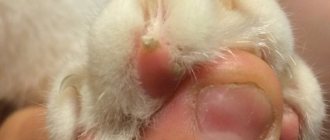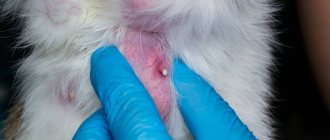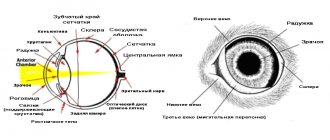The diseases that pets suffer from are quite simple and common, and sometimes they are rare and unusual in their manifestations. These diseases include cutaneous horn. With this pathology, growths appear, each of which looks like a claw growing, for example, on the pad of a cat's paw.
Signs of appearance
In veterinary medicine, this disease is diagnosed quite rarely. And the cat owner may even mistake it for an ordinary claw. Upon closer examination, you can see that this growth:
- dense and hard to the touch;
- with a rough surface;
- conical or cylindrical;
- light or dark color;
- does not exceed 5 cm in length.
Most often, growths appear on the paw pads, but they can also appear on the eyelids, on the nose, and near the animal’s anus. According to the observations of veterinarians, representatives of the Scottish or British breed of cats are especially susceptible to this disease.
Diagnosis and treatment
The reason for the formation of the growth is determined during a clinical examination taking into account the medical history. The blood is analyzed for viruses, and if necessary, a biopsy specimen is taken for histological examination.
The veterinarian decides what to do:
- Observe.
- Use conservative treatment methods.
- Remove the tumor surgically.
- Apply chemotherapy or radiation methods.
For conservative treatment, the veterinarian prescribes the following medications and monitors their use:
- Retinoids: Acitretin or Etretinate. Prevents keratinization and pathological tissue proliferation.
- Aldara is an immunomodulating cream, a non-specific agent that increases the body's resistance to viruses, fungi and bacteria.
- Azithromycin is an antibiotic. The veterinarian selects the dosage and course of treatment individually.
When surgically removing a tumor, the following methods are used:
- laser burning;
- cryotherapy with liquid nitrogen;
- excision - used for extensive growth of pathological tissue.
If after removal of the tumor it grows back, radiotherapy or chemotherapy is prescribed.
Reasons for appearance
The appearance of such growths is a pathology in which the process of keratin formation and keratinization of cells in the upper layer of the skin occurs too intensely.
The development of the disease can be caused by various provoking factors. The most common of them is the presence of papilloma virus in the animal’s body. It has the ability to transform epithelial cells, causing the growth of warts, growths on the paw pads of cats or other skin formations.
The causes of neoplasms may also be:
- Injury to the claws, their break at the very base or complete separation. In this case, when a new claw is formed, excessive growth of skin tissue is possible.
- Chemical burn or other damage to the skin. The affected area of skin needs a new layer. At the site of damage during the regeneration process, keratinization occurs faster and a so-called horn can form.
- In addition to the papilloma virus, neoplasms and tumors can provoke another fatal disease. The causative agent of viral leukemia suppresses the animal’s immunity and promotes the growth of malignant tumors.
- In most cases, growths in cats are not dangerous and are benign. However, about 5% of neoplasms are malignant. They may be symptoms of squamous cell carcinoma or another cancer.
- In some cases, the pet's growth may turn out to be a cyst.
How to treat cutaneous horn?
Use of veterinary drugs
According to veterinarian statistics, the pathology occurs mainly in Scottish and British cats, and in 5% of animals the growth degenerates into a malignant form.
All medications are prescribed by a veterinarian; self-medication is prohibited. To soften the skin horn and avoid secondary infection, Levomekol liniment should be applied. It has antibacterial properties and heals cracks. The growths are smeared 2-3 times. per day, wrapping the paw to prevent the cat from licking the ointment. Synthetic retinoids are also used to suppress the growth of growth. “Acitretin” is effective, which has regenerating properties and helps reduce keratinization. When a bacterial infection occurs, the pet is prescribed the antibiotic Azithromycin.
Surgery and laser treatment
If the formation grows, surgical intervention is used to remove the pathology.
If the cutaneous horn is very large or grows, surgery is performed to remove the affected skin. The area is stitched or cauterized with liquid nitrogen. After healing, a crust remains, which then falls off. However, cryotherapy is painful, so veterinarians recommend laser removal. The procedure is quick, does not cause pain, and does not leave wounds or scars.
Home therapy
Traditional medicine does not replace traditional treatment and should be agreed with a veterinarian. Popular and often recommended by incompetent people, lotions based on bay leaves or aloe are toxic to cats and can cause poisoning, impaired coordination of movements and seizures. Cutaneous horn on the pads of a cat can be effectively treated with vegetable oil. The liquid should be applied daily to the affected limb. A propolis compress helps, a piece of which should be wrapped with a bandage to the paw.
Drug therapy
To eliminate cutaneous horn in cats, the necessary treatment is selected only after conducting research, studying tests, and establishing the cause of the pathology.
In some cases, when there is no need for surgical intervention, it is permissible to treat your pet at home. You can treat yourself using medications that are prescribed by a veterinarian. For a certain form of the disease, the most suitable drugs are used.
When the disease is viral in nature, various immunomodulators are used. Such drugs include Aldara cream. When the cream comes into contact with the skin, the substances included in its composition stimulate the body’s immune response and increase the production of interferon.
Rules for using the drug:
- it is applied directly to the affected area, rubbed until completely absorbed;
- treatment is carried out no more than 3 times a week, every other day;
- It is necessary to ensure that the cat does not lick the medicine.
The product "Acitretin" is classified as dermatotropic and has the following properties:
- stimulates tissue regeneration;
- promotes the resorption of scars;
- normalizes the processes of skin keratinization;
The drug must be used strictly under the supervision of a veterinarian, since its mechanism of action remains unknown.
You should know that such remedies only eliminate skin keratinization, affecting only the symptoms of the disease, but not its cause.
To act directly on the causative agents of skin infections, antibiotics should be used. Azithromycin is an antimicrobial drug that is effective against a wide variety of microorganisms. They are usually treated with antibiotics for 10 to 14 days.
Symptoms: how does the disease manifest itself?
The appearance of growths can be determined by the visual lengthening of the finger on which the skin becomes rough.
A cat's cutaneous horn resembles an extra claw that grows from the top of the pad. Signs:
- roughening of the skin according to the callous type;
- visual lengthening of the finger;
- dryness and hardness of the skin;
- growth of the process up to 4-5 cm in length and curvature;
- the appearance of cracks and bleeding ulcers;
- pain if erosion occurs.
Treatment of papillomas in cats at home
Before trying to treat a cat for papilloma at home, it is necessary to determine the cause of the wart. After all, sometimes squamous cell carcinoma can be mistaken for papilloma. But the therapy in these cases is different.
If your pet has warts that prevent him from eating, or can rub (the adjacent tissues are in too close contact with the papilloma), then it is best to resort to the surgical method. Cryogenic and laser therapy are also used in veterinary medicine, but these methods of treating mustache must be repeated. Yes, and not very cheap methods of surgical intervention, but the most effective.
The pet can be administered interferon and other antiviral drugs in a course (at least 3 months). Even if the papillomas have disappeared, this is not a reason to cancel interferon treatment. On the contrary, in order to consolidate the positive result, it is necessary to administer antiviral drugs for another month after the disappearance of the last papilloma.
As an option, you can use a special vaccine - papillomavirus. Finding it is not so easy; not every veterinary clinic or pharmacy has it, but the animal develops a strong immunity, and the warts disappear on their own. If the neoplasms are pigmented, then they must be carefully examined, studied, and, if necessary, a biopsy performed to exclude squamous cell carcinoma. And some owners may confuse a “colored” wart with a mole.
When to contact a specialist?
It is necessary to visit a veterinarian if there are a large number of growths on the back legs of cats (or on the front legs). If your pet is unwell and the regular occurrence of pain during the animal’s movements should also be a cause for concern.
In addition to drug treatment, the veterinarian may offer the following treatment options:
- Laser surgery. In this way, it is possible to safely get rid of the growth on the animal’s paws. The laser leaves no traces and allows you to effectively fight the virus;
- Surgical method. Used if the area of build-up is too large. Using a scalpel, skin pathology is eliminated, however, after the operation, scars may remain and formations may reappear;
- Cryotherapy. This is a painful procedure, as the skin lesion is treated with liquid nitrogen. A dry crust appears at the site of the growth after the procedure;
None Some cat owners use traditional methods to treat growths. These include the use of aloe leaves, propolis, juniper and bay leaves, as well as the use of vegetable oil.
You can prevent the occurrence of such a pathology if you carefully monitor your pet’s health. It is important to notice changes in his health and undergo a preventive examination with a veterinarian twice a year.
Text of the article and photos from the book SMALL ANIMAL DERMATOLOGY A COLOR ATLAS AND THERAPEUTIC GUIDE 2022 Translation from English: veterinarian Vasiliev AV
[custom_ads_shortcode2]
Features of the pathology
The skin horn can be light or dark in color and has a dense consistency. The surface of the growth is rough due to the presence of grooves. The size of the neoplasm on the cat's paw pad does not exceed 5 cm.
When a growth appears, the pet does not experience any discomfort, and the formation itself is most often benign. When pressing on the “skin horn,” the cat may experience discomfort due to the fact that the appearance of the growth is inflammatory in nature.
In 5% of cases, horny growths on a cat’s paw pads indicate oncology. If a skin pathology is detected, the pet owner should not try to eliminate the formation on their own. It is easy to purchase one of the recommended medications at the pharmacy, which will stop the process of skin horn development.
[custom_ads_shortcode2]
Allergens in food
With a chronic latent course, the skin is constantly dry and flaky, the coat is brittle and dull, there is no itching. Although the wet type is also possible - weeping, highly inflamed and reddened areas of the skin, on the surface of which ichor constantly appears.
It is almost impossible to cure atopic dermatitis caused by a reaction to an allergen in food. However, a cat can live a full and happy life if the allergen is identified and its entry into the body is stopped. To do this, you need to take blood tests (it’s better to immediately do an extended analysis for 24 positions) and, together with a veterinarian, choose a diet.
Kinds
There are several types of papillomas in cats.
Oral papilloma
The most common type of warts is found in meowing mustaches 6-9 months old. They appear in the oral cavity, most often on the tongue. Papillomas are oval elevations (numerous) with a flattened top. Warts are usually 4-9 mm wide (diameter).
Multiple viral
Multiple viral papillomas appear in older cats (elderly or middle-aged). Lesions occur over the entire surface of the body (there is no specific localization). The warts are numerous and vary in size (from a few millimeters to 3 cm). There are elongated ones, and in the form of pigmented plaques, and compactions (hyperkeratosis). Some of the papillomas may “degenerate” and the animal will develop squamous cell carcinoma.
Single skin papillomas in cats
This type of papillomas in cats is extremely rarely recorded. Single small warts are observed on the pet's skin. Most often, the disease develops in adult whiskers. Scientists have not been able to prove that this type of wart appears due to a virus.











